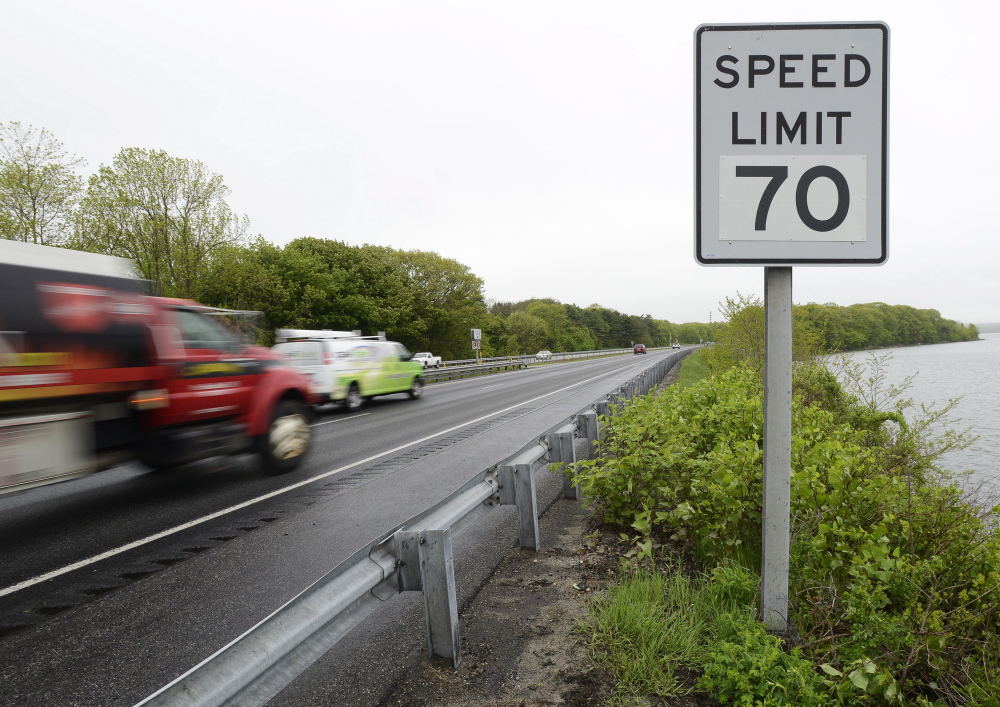The Maine Turnpike Authority is considering raising the speed limit so that motorists on most of the state’s highway system can drive at the same maximum speed.
Unlike the Maine Department of Transportation, which recently raised the speed limit from 65 to 70 mph on most other portions of Maine’s interstate highways without advance notice or a public process, the turnpike authority must solicit opinions from residents before making any changes.
Even top state lawmakers said they were caught off-guard by the Department of Transportation’s speed limit increase.
In late May, Sen. Ed Mazurek, co-chair of the Legislature’s Transportation Committee, received an email from a top official in the department. That’s how he learned that the speed limit was being increased for most interstates, he said.
“It came out of the blue,” said Mazurek, who learned about the new speed limit one day before the information became public in a newspaper story.
Not that Mazurek is complaining much. The speed limit was raised under a process that lawmakers established last year when they passed a law transferring the power to set highway speeds from the Legislature to the transportation commissioner and the state police chief.
Mazurek, a Democrat from Rockland, said the speed limit issue had become a “political football” in the Legislature, and he prefers to leave the decision to professionals. Still, he wishes the Department of Transportation had given the public a chance to express opinions before making the change.
Also surprised by the news was Pat Moody, spokesman for AAA Northern New England, which opposed raising the speed limit when the change was discussed last year because it feared that higher speeds would cause more serious crashes.
On the day officials announced the change, he said, highway crews were already changing the speed limit signs.
While he respects the work of traffic engineers, Moody said, they might have gained additional information by giving the public a chance to speak.
“It’s a big enough issue. It impacts enough people,” he said. “A lot of people use that highway, and it would have been good to allow the public to have input.”
Department of Transportation spokesman Ted Talbot said the department simply followed the process set up by the Legislature, which authorized Transportation Commissioner David Bernhardt to study the issue and make a decision, subject to approval by state police Col. Robert Williams.
“This did not call for a public process,” he said.
That’s what the Maine Turnpike Authority is about to begin.
The state law that created the authority says it cannot make any changes without first soliciting comments from public.
The law also says that the turnpike’s speed limit cannot be more than 65 mph, except as it may be permitted “on similar roads in the state.”
That’s why the turnpike authority has scheduled a public hearing for 4 p.m. June 19 at its headquarters, at 2360 Congress St. in Portland.
The proposal would raise the speed limit from 65 to 70 mph on nearly every section of the turnpike, which is part of Interstate 95.
The change would make the maximum speed consistent along most of I-95 as far north as Old Town. The speed limit between Old Town and Houlton was raised from 65 to 75 mph in 2011.
The two-mile stretch of I-95 closest to the New Hampshire border is not part of the turnpike, so that area is not covered by the proposal. The speed limit there is 65 mph.
The speed limit would be increased from 55 to 60 mph between mile 44 in Scarborough and mile 52 in Falmouth. The speed limit on the Falmouth Spur would increase to 60 mph.
Because of the required process, the turnpike authority won’t be able to change the speed limit until sometime in July, said Peter Mills, the authority’s executive director.
Mills said it makes sense to raise the speed limit because Maine’s interstates have been made safer, with improvements such as added guardrails in the medians. More importantly, he said, a consistent maximum speed limit on all of Maine’s interstates would spare motorists any confusion about how fast they should be driving.
Stephen Landry, the Department of Transportation’s state traffic engineer, said the decision to raise the speed limit followed a six-month study of crash data and average speeds. He said it’s safer if the limit is set at a speed that most people are driving.
Landry said the department often gets requests from the public and municipalities to lower speed limits. To keep the issue from becoming political, he said, it’s best that such decisions are based on data, rather than emotion.
“It’s data-driven and metrics. That’s how we determine speed,” Landry said. “We pretty much go with the facts and not how people feel.”
Tom Bell can be contacted at 791-6369 or at:
tbell@pressherald.com
Send questions/comments to the editors.



Success. Please wait for the page to reload. If the page does not reload within 5 seconds, please refresh the page.
Enter your email and password to access comments.
Hi, to comment on stories you must . This profile is in addition to your subscription and website login.
Already have a commenting profile? .
Invalid username/password.
Please check your email to confirm and complete your registration.
Only subscribers are eligible to post comments. Please subscribe or login first for digital access. Here’s why.
Use the form below to reset your password. When you've submitted your account email, we will send an email with a reset code.